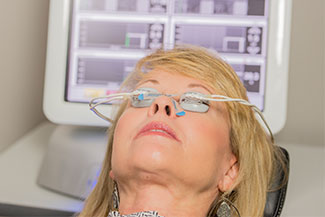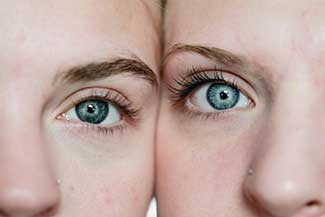Blepharitis: Causes & Treatments
Blepharitis
Blepharitis is an eye condition characterized by an inflammation of the eyelids which causes redness, itching and irritation. The underlying cause of blepharitis can vary and is often multifactorial.
The common eye condition is caused by either a skin disorder, demodex mites, or a bacterial infection.
Blepharitis is generally not contagious and can affect patients of any age. While it can be very uncomfortable, it usually does not pose any danger to your vision.
There are two types of blepharitis: anterior and posterior.
- Anterior blepharitis occurs on the front of your eyelids in the area where the eyelashes attach to the lid. This form is less common and is usually caused by a bacterial infection or seborrheic dermatitis, which is a skin disorder (dandruff) that causes flaking and itching of the skin on the scalp and eyebrows. Allergies or demodex mites on the eyelashes can also lead to this condition.
- Posterior blepharitis occurs on the inner eyelid that is closer to the actual eyeball. This more common form is often caused by rosacea, dandruff or meibomian gland dysfunction (MGD) which affect the production of oil in your eyelids.
Some of the common causes include:
Bacterial infection: Bacteria, such as Staphylococcus, can colonize the skin and eyelids, leading to inflammation.
Meibomian gland dysfunction (MGD): The meibomian glands located along the eyelid margins secrete oils that help lubricate the eyes. Dysfunction of these glands can result in an imbalance of oil production, leading to the development of blepharitis. Some of our treatments for MGD include: LipiFlow, iLux, and meibo.
Demodex mites: These microscopic mites inhabit the eyelash follicles and can contribute to inflammation when their numbers increase. We can treat demodex mites through treatments like Lumenis IPL and Xdemvy.
Allergic reactions: Allergens, such as pollen or certain cosmetics, can trigger an allergic response in the eyelids, leading to blepharitis symptoms.
Symptoms of Blepharitis
Blepharitis can vary greatly in severity and cause a variety of symptoms which include:
- Red, swollen eyelids
- Itching
- Burning or gritty sensation
- Excessive tearing
- Dry eyes
- Crusting on eyelids
If left untreated, symptoms can become more severe such as:
- Blurred vision
- Infections and styes
- Loss of eyelashes or crooked eyelashes
- Eye inflammation or erosion, particularly the cornea
- Dilated capillaries
- Irregular eyelid margin
Treatment for Blepharitis
Dr. Arlene Schwartz at Hartsdale Family Eyecare is a specialist who provides comprehensive care for various eye conditions, including blepharitis. She focuses on diagnosing and managing blepharitis by addressing its underlying causes. Dr. Schwartz’s approach may include:
-
Thorough examination: Dr. Schwartz will perform a comprehensive eye examination to assess the severity and underlying causes of blepharitis. This may involve evaluating the eyelids, tear film quality, and the function of the meibomian glands.
-
Treatment plan: Treatment for blepharitis depends on the cause of the condition but a very important aspect is keeping the eyelids clean. Based on the examination findings, Dr. Schwartz will develop a customized treatment plan tailored to the individual patient. Treatment options may include:
-
Eyelid hygiene: Dr. Schwartz may recommend regular eyelid cleansing routines using warm compresses and gentle eyelid scrubs to remove debris, bacteria, or excess oils.
Warm compresses are usually recommended to soak the lids and loosen any crust to be washed away. It is recommended to use a gentle cleaner such as Ocusoft Hypochlor Spray, but Hyclear Hypochlorous Spray is now the ideal choice to clean the area.
HyClear is the next generation of hypochlorous acid for essential daily eyelid health management. With a broad-spectrum of antimicrobial activity from the pure hypochlorous acid .01%, HyClear kills most ocular pathogens in 15 seconds*.
-
-
Medications: Depending on the specific case, Dr. Schwartz may prescribe antibiotics or corticosteroids to address bacterial infections or reduce inflammation. In serious cases, steroidal treatment (usually drops) may be used.
-
Meibomian gland management: Dr. Schwartz may suggest techniques such as warm compresses, manual expression of the glands, or specialized devices to help manage meibomian gland dysfunction.
-
Allergy management: If allergies contribute to blepharitis, Dr. Schwartz may recommend identifying and avoiding allergens or using antihistamine eye drops to manage symptoms.
-
Ongoing care: Dr. Schwartz will provide ongoing monitoring and follow-up care to ensure the treatment plan is effective and make any necessary adjustments.
Blepharitis is typically a recurring condition so here are some tips for dealing with flare-ups:
- Use an anti-dandruff shampoo when washing your hair
- Massage the eyelids to release the oil from the meibomian glands
- Use artificial tears to moisten eyes when they feel dry
- Consider breaking from use of contact lenses during the time of the flare-up and or switching to daily disposable lenses.
The most important way to increase your comfort with blepharitis is by keeping good eyelid hygiene. We have an in-office procedure to reduce and alleviate blepharitis called BlephEx. It treats Demodex mites. Speak to Dr. Schwartz about which treatment is best for you.
Learn More About Dry Eye Technologies
Blepharitis is typically a recurring condition so here are some tips for dealing with flare-ups:
- Use an anti-dandruff shampoo when washing your hair
- Massage the eyelids to release the oil from the meibomian glands
- Use artificial tears to moisten eyes when they feel dry
- Consider breaking from use of contact lenses during the time of the flare-up and or switching to daily disposable lenses.
The most important way to increase your comfort with blepharitis is by keeping good eyelid hygiene. We have an in-office procedure to reduce and alleviate blepharitis called BlephEx. It treats Demodex mites. Speak to Dr. Schwartz about which treatment is best for you.






